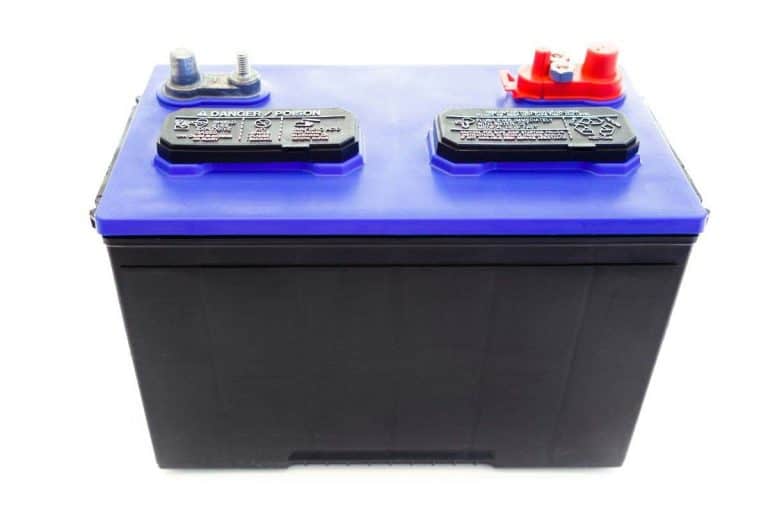The Ultimate Guide To How Jet Ski Motors Work
If you’re a jet ski lover, then merely mastering the controls isn’t enough. You must also know how exactly jet skis work. Unfortunately, most people don’t know how a jet ski works and think it’s the motor that pushes the jet ski, which is somewhat incorrect. So how does a jet ski motor work?
Jet skis pull the water, and the engine pushes it from the back in the form of a stream. The stream causes the jet ski to move forward. A powerful motor will push the water with greater force, creating a powerful stream to let jet skis achieve a faster speed.
The jet ski’s concept might not be clear from the above two lines, so keep reading this article until the end so we can get to the bottom of this. It’s the ultimate friendly guide to how a jet ski motor works.

Understanding The Science Behind Jet Ski Propulsion
The way a jet ski works is pure science, so let’s try to learn it. This section deals with the scientific concepts and relevant examples that explain how a jet ski motor works. You may or may not be aware of Newton’s third law of motion– if an object exerts a force on another object, the force receiving object exerts the same amount of force immediately in the opposite direction.
In other words, for every action, there is an equal and opposite reaction. You’re sure to have heard that before, right?
Some Examples of How Propulsion Works
Let’s take a look at a few examples for a better understanding.
- Suppose you fill a balloon with air; enough so that it’s about to explode. Leave the balloon untied, and it’ll fly around in the nearby surroundings.
- Imagine you’re on a skateboard, and you want to move forward. You’ll kick the ground backward so that the same amount of force is received by your foot, hence your leg, causing the skateboard to move forward.
Jet skis work in a much similar fashion.
Conservation Of Momentum
You must understand that a weak jet stream won’t be enough to push the Personal Watercraft (PWC). According to the scientific laws, the momentum of the water stream (fired by the jet ski) must be equal to the jet ski momentum (including the passengers’ weight). The formula for momentum is as follows:
P = MV
Here P = momentum, M= mass, V= velocity
A jet ski can weigh around 800lbs (400 Kg) or more. The weight of the water stream won’t be anywhere near to the PWC’s weight. So, to achieve velocity, the jetski must fire the water stream at an insane speed. The water stream is responsible for the water surface at the back of a jet stream that gets all churned up.
The Workings of a Jet Ski Motor
If the science above made this article boring, let’s bring down the technical level and introduce some basic facts about a jet skis propulsion motor. This section directly deals with the explanation of how a PWC works.
- Every PWC has a large intake grate at the bottom of the hull. It is where the water enters into the jet ski. Water is sucked in large amounts to eliminate the shortage of water in the jet ski.
- The water then reaches the engine, which is responsible for powering the impeller and the water pump. Any jet ski would have a gasoline engine, which of course runs on fuel. The engine is cranked by electric ignition. For this, you’ll have to turn the key, which will connect the circuit and cause a spark inside the engine. The electric ignition is achieved by the marine battery installed in the PWC.
Your PWC might have a 1500cc, four-stroke, four-cylinder engine, etc. These engines are approximately as powerful as those in a hatchback car or a large motorcycle. A jet ski’s engine has a 20 gallon (approx.) fuel tank, which minimizes the risk of running out of fuel while on a long journey.
- The water pump and its impeller suck the water from one end of the pipe and throw it at an insane velocity from the other end of the pipe. The water then exits from the water exit hole present at the back of the jet ski.
This impeller is similar to a propeller, which is completely installed inside the pipe. This impeller usually has three blades made of stainless steel. While most water is pushed in the form of a jet stream, a small amount is also used to cool the engine.
- The water exit hole is technically known as a “steerable nozzle.” The diameter of this nozzle is relatively smaller than the intake grate. This reduced diameter helps increase the water pressure during its exit, which creates a powerful jet stream exiting the PWC at a very high velocity.
However, reducing the diameter too much will also be a problem because the jet stream would then get weaker, wasting the engine’s power. In the worst-case scenario, it might even blow the engine. Hence the manufacturers precisely calculate this diameter based on the engine’s power. This stuff is very scientific; hence no point in going deeper.
- When taking turns, the steerable nozzle changes its direction as well. It allows a rider to maintain grip and stability and offers efficient handling.
More Elaborated Explanations About Jet Ski Motors
Now that you’ve learned the basic workings of a PWC, you’d probably like to learn the more elaborate explanation of the motor function (discussed above). How does the water enter the jet ski? How does the jet ski maintain the water pressure? Can a jet ski run out of water? We’ll discuss many more similar exciting questions now.
A Jet Skis Impeller And Its Workings
As discussed above, the water reaches the impeller through the intake grate. Let’s learn more about the impeller and how it works.
The impeller is a fan, similar to a regular fan (which is meant to move air). When attached to a water pump, the impeller acts as a propeller, which sucks the water and pushes it along its path. Since it’s installed in the pipe, the water has nowhere else to go but to exit through the other end of the pipe. It creates immense pressure, which is much like how the blood flows in our veins.
When the blood veins squeeze, their diameter decreases, which causes increased blood pressure. Similarly, when the pipe’s diameter is decreased concerning the engine’s power, the water pressure increases, generating a much more powerful thrust.
Since the engine powers the impeller, small engines deliver less power to the impeller, which produces a weaker stream. It is the reason why the prices of jet skis differ based on their engine power.
PWC Motors And Their Workings
Most of the common jet skis have a 150 HP engine. It means that the engine can generate power equal to 150 horses. It’s a traditional (ancient) method of measuring power, which is still prevalent today.
A lot of people modify their PWCs by installing a motorcycle engine with a similar power rating. Such a modification must only be performed by a licensed professional as you take the risk of blowing up your PWC (if you don’t have enough experience).
The improper installation does pose several risks, but properly installed engines can let you alter your PWC’s top speed, and you might achieve a high-end speed of up to 40 mph. Just remember that the speed of a jet ski depends on the power rating of the motor.
Jet Skis With 2-Stroke Engines
Although 2-stroke engines are inferior and have generally been replaced by modern 4-stroke engines, you’ll still find countless PWCs with a 2-stroke engine. Surprisingly, they’re still manufactured. These engines usually have 2 or 3 cylinders. Jet skis with a 2-stroke engine feature a smaller hull, resulting in a lack of seating and storage capacity.
Advantages of a Jet Ski With a 2-Stroke Engine
Let’s discuss a couple of benefits of a 2-stroke jet ski.
Compact Size
As compared to 4-stroke engines, jet skis with a 2-stroke engine are far lighter and smaller. This aids power and mileage even though they’re less powerful engines. You can tow these jet skis with a smaller car, and you can even haul them in a truck bed.
Sweet and Simple
2-stroke jet skis have fewer moving parts. It makes them simple and more comfortable to repair. However, there are a lot of items absent in the system. The included parts are less vulnerable to failure, but once they fail, it’s suggested to replace them instead of repairing them.
Ease Of Repair
A 2-stroke engine is super easy to repair, and you can even assemble the entire system in your garage, provided that you possess the necessary skills and experience. There’s no need to change the oil in them either as oil is added to the fuel in a 2-stroke engine.
Jet ski owners are less likely to need to go to a professional mechanic if they have enough knowledge about repairing the jet ski. Even if these engines are near the end of their life or have been blown, rebuilding them is still economically friendly.
Cheaper
It’s a less complicated technology, and with the emergence of better technology in the market, jet skis with 2-stroke engines have become much cheaper and more affordable. Here, cheap doesn’t necessarily mean an inferior product. The other reason for the low price is lower manufacturing costs.
Disadvantages of Jet Skis With a 2-Stroke Engine
2-stroke engines have a couple of limitations and issues as follows:
Maintenance Issues
These engines demand a lot of regular maintenance to ensure longevity. As compared to 4-stroke engines, these are far less reliable despite all the maintenance and care. You can’t even think of abusing these jet skis. Many users complain that a simple “carb problem” requires professional servicing, which can be troublesome.
Other common issues with these engines include:
- Leaving the jet ski unused for a long time results in fuel evaporation. As a result, excess leftover oil in the fuel tank can cause oiled spark plugs whenever you start the engine the next time. The oiled spark doesn’t allow the jet ski to start, and you’ll have to call for professional help to get it fixed.
- These engines require regular carburetor adjustment to reach optimal performance.
- Fuel-injected 2-stroke jet skis require even more attention. A system failure will not only be hard to fix but will also cost a lot of money.
Durability
They’re not durable, and here are a couple of good reasons:
- 2-stroke engines burn oil regularly with the gas. It is an indication that they don’t have an efficient lubrication system, which makes the internal parts wear much faster.
- Running a 2-stroke engine without oil can destroy it within a few seconds.
- They run at higher RPMs, which again wears the internal parts much faster.
- If you’re running these engines on a premix, that’s again another major issue. Using a premix means you’re mixing the oil with gas before pouring the solution into the jet ski. In case if you ever forgot to add the oil, it’ll leave the engine unlubricated.
- Some 2-stroke systems have a separate oil pump, in which you’ll have to pour the oil. This oil is mixed with the gas when the jet ski is in action. A malfunction can lead to improper lubrication, which can damage or destroy the engine.
Lacking Parts & Service
Most mechanics refuse to work on a jet ski that is more than ten years old. As a result, many vintage jet ski owners find it super challenging to find the right professional. Also, some greedy mechanics tend to take advantage of the owners and charge unreasonably high rates just because fewer professionals are willing to work on these PWCs.
The second issue is that you’re less likely to find the spare parts with each passing year. Even if you’re lucky enough to find the parts, you can’t be sure of their quality.
Limited Travel Range
In the most straightforward terms, a 2-stoke jet ski isn’t suited for a long trip. There are a couple of reasons for that:
- Smaller fuel tank, which means less fuel storage capacity.
- Low mileage, which means that it’ll consume the limited fuel much quicker.
- Small seats, which hinder the seating comfort during long journeys.
- Smaller storage compartment(s), which means you can carry fewer essentials.

Jet Skis With 4-Stroke Engines
The piston in a 4-stroke engine performs two strokes in each revolution. One is a compression stroke, and the other is an exhaust stroke, each followed by a return stroke, making a total of 4, hence the name 4-stroke engine. There’s no need to premix the oil and fuel (unlike in a 2-stroke model), as there’s a separate oil compartment.
Advantages of a Jet Ski With a 4-Stroke Engine
- 4-stroke engines consume fuel once every four strokes, hence offer better mileage.
- These engines can produce higher torque at lower RPMs. It’s because they weigh 50% more than 2-stroke engines. It also means that the internal parts wear slowly as compared to a 2-stroke engine. Hence, these engines become more durable and long-lasting.
- They’re less noisy and much quieter than a 2-stroke engine, which creates a high-pitched buzzing sound.
- Unlike 2-stroke engines, 4-stroke engines are environmentally-friendly, as the burnt oil isn’t released in the air.
- The applications of 4-stroke engines in a jet ski make them suited for a more extended trip as they aid mileage, offer better seating and storage space, and much more.
- Fortunately, they require less maintenance.
Disadvantages of a Jet Ski With a 4-Stroke Engine
- 2-stroke engines are still arguably more powerful than 4-stroke engines.
- 4-stroke engines have an intricate design, making it difficult for many professionals to work on them. Furthermore, they require more time to fix even a minor issue. The repair costs will often be higher than expected.
Jet Ski Motors: A Few Maintenance Tips
Perhaps the next thing you’d like to know is a few maintenance tips. Now that you’ve learned the technical aspects of how a jet ski motor works, the maintenance tips below will sound more sensible since you can understand them better now. Whether it’s a 2-stroke or a 4-stroke jet ski, these tips are suited for both.
1. Inspect The Spark Plugs
As discussed above, spark plugs may have excess oil if the fuel evaporates. Additionally, when the jet ski remains idle during winters, plugs might collect debris, which can cause starting problems.
Just like oil, excess fuel is terrible too. Excess fuel on spark plugs indicates that someone overfilled the fuel tank. Finally, merely leaving a jet ski idle for too long can damage the spark plugs without any reason.
2. Inspect Loose Parts
Jet skis can receive damage without you knowing while in action. Ensure that you inspect the ski for possible loose wiring, broken or damaged parts, etc. You must never start the engine if you can smell fuel. It indicates a possible fuel tank leak or damage. Loose cables can also indicate the same thing.
Finally, you must test all the switches and controls to ensure they’re receiving adequate power.
3. Check The Battery
A battery can die anytime and anywhere without any prior warnings. If the batteries are working, ensure that the posts are clean and free from debris. Also, it would help if you fully charged the batteries before leaving for a trip.
If the batteries are kept 100% charged, sulfate crystals won’t form on the plates. A maintenance charger is a great device to ensure the longevity of your jet ski battery. It’s cheap and worth investing money in.
4. Flush The Engine
Now you know that there’s a large intake grate at the bottom of the hull. There’s a reasonably high chance that an outing may have caused the grate to collect debris, sand, algae, salt, etc., in the internal parts. It’s a good practice to flush the engine. Whether you’re riding it in salt water or fresh water, it hardly matters.
You must drain all the water out of the exhaust. If the water drains properly, it indicates no blockage in the internal parts. To drain the internals, twist the throttle. Keep running the engine while water is added to the internal system for flushing.
Frequently Asked Questions (FAQs)
Are jet skis expensive to maintain?
Depending on the gas prices and the usage of a jet ski, you can expect to spend thousands of dollars annually. This expense can increase further considering the added maintenance cost and repair bills (if any).
How often should you service a jet ski?
It’s advisable to get your jet ski serviced once every 50 hours of use. It would be best to get the oil changed once every year or 50 hours, whichever is earlier. Unfortunately, they might charge you $200 to $500 just for a simple oil change.
Which is the most recommended jet ski brand?
WaveRunner FX has gained a lot of popularity and is considered among the most recommended jet ski brands. Yamaha manufactures the PWC, and the name itself says a lot about the incredible quality.
Is saltwater bad for jet skis?
When the water enters from the intake grate, salt can collect in the internal system over time with repeated use. Saltwater will be bad for jet skis (in the long run) if you don’t occasionally flush the engine (discussed above). However, it won’t be a significant concern.
Jet Ski Conclusions
By the end of this article, you have learned the science behind how a jet ski engine works. Also, we’ve covered briefly how a 2-stroke and 4-stroke engine works, what their complications are, etc. Our job was to offer you the right information, and now it’s your turn to go through it and re-read this article if necessary.
Finally, we suggest you consider the maintenance tips (discussed above) seriously, as they can help you save a lot of money and eliminate unnecessary jet ski troubles. Good luck and have fun!
Sources:






